Pearlwort is a common name for several plants and may refer to:
Pearlwort is a common name for several plants and may refer to:
Sycamore is a name which has been applied to several types of trees, but with somewhat similar leaf forms. The name derives from the ancient Greek σῡκόμορος (sykómoros) meaning "fig-mulberry".

Groundcover or ground cover is any plant that grows over an area of ground. Groundcover provides protection of the topsoil from erosion and drought.

Caryophyllaceae, commonly called the pink family or carnation family, is a family of flowering plants. It is included in the dicotyledon order Caryophyllales in the APG III system, alongside 33 other families, including Amaranthaceae, Cactaceae, and Polygonaceae. It is a large family, with 81 genera and about 2,625 known species.

Reed is a common name for several tall, grass-like plants of wetlands.

Colobanthus quitensis, the Antarctic pearlwort, is one of two native flowering plants found in the Antarctic region. It has yellow flowers and grows about 5 cm tall, with a cushion-like growth habit that gives it a moss-like appearance.

Sagina subulata, the heath pearlwort, Irish-moss, awl-leaf pearlwort or Scottish moss, is a species of flowering plant in the pink and carnation family Caryophyllaceae. It is native to Europe, from Iceland south to Spain, and east to southern Sweden and Romania. It occurs on dry sandy or gravelly soils.
Camphorweed is a common name for several plants and may refer to:
S. nivalis may refer to:
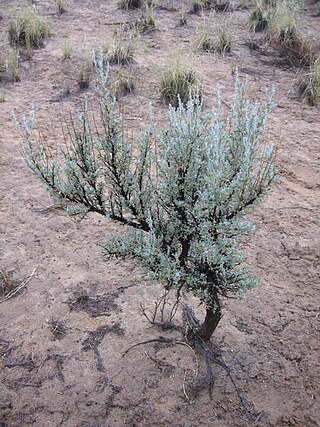
Sagebrush is the common name of several woody and herbaceous species of plants in the genus Artemisia. The best-known sagebrush is the shrub Artemisia tridentata. Sagebrushes are native to the North American west.

Sagina apetala is a species of flowering plant in the family Caryophyllaceae known by the common names annual pearlwort and dwarf pearlwort. It is native to Europe and it is known elsewhere as an introduced species, including parts of North America. It grows in many types of disturbed habitat, such as cracks in the sidewalk. It is a petite annual herb producing a threadlike stem just a few centimeters long, spreading or growing erect. The plant is glandular and somewhat hairy. The leaves are linear in shape and not more than about a centimeter long. The inflorescence is a solitary flower borne on a threadlike pedicel. The flower has usually four sepals and generally no petals.

Sagina decumbens is a species of flowering plant in the family Caryophyllaceae known by the common names trailing pearlwort and western pearlwort. It is native to several areas of North America, where it can be found in many types of habitat. It is a small annual herb producing a threadlike green or purplish stem growing erect or trailing, measuring up to about 16 centimeters long. The leaves are hairless, linear in shape, and one half to two centimeters long. The inflorescence is a solitary flower borne on a threadlike pedicel. The flower has usually five sepals and five tiny white petals. There are two subspecies which differ mainly in the microscopic appearance of the seeds.

Sagina maxima is a species of flowering plant in the family Caryophyllaceae known by the common names stickystem pearlwort and thick-stemmed pearlwort. It is native to the west coast of North America from Alaska to California, where it can be found in many types of sandy and rocky coastal habitat. It is a small, fleshy perennial herb growing in a clump of linear leaves and thick stems. The fleshy, pointed leaves are 1 or 2 centimeters long. The inflorescence is a solitary flower with five sepals and five small white petals. There are two subspecies which differ mainly in the arrangement of hairs on the stem.

Sagina procumbens is a species of flowering plant. in the family Caryophyllaceae known by the common names procumbent pearlwort, birdeye pearlwort and matted pearlwort. It can be found throughout the Northern Hemisphere and parts of South America. It is a common weed of many environments. It can be found in wild and disturbed habitat, especially moist areas. It can sometimes be seen growing in lawns or in cracks in pavements. This is a perennial herb forming clumps or mats of hairless green herbage, sometimes vaguely resembling a patch of moss. The leaves are linear and up to 1 or 2 centimeters long. The inflorescence is a solitary flower with four or five sepals and four or five small white petals, but the petals are sometimes absent.

Sagina saginoides is a species of flowering plant in the family Caryophyllaceae known by the common names arctic pearlwort or alpine pearlwort. It has a circumboreal distribution; it can be found throughout the northern latitudes of the Northern Hemisphere. It grows in subalpine and alpine climates and other mountainous habitat at lower elevations. This is a small perennial herb producing a slender to threadlike stem just a few centimetres long, growing decumbent or erect. It is sometimes clumpy in form. The leaves are linear in shape and about 1 to 2 centimetres in length. The inflorescence is a solitary flower with five sepals and five small white petals.
The Joubin Islands are a group of small islands lying 6 kilometres (3 nmi) south-west of Cape Monaco, Anvers Island, at the south-western end of the Palmer Archipelago of Antarctica. The islands were discovered by the French Antarctic Expedition, 1903–05, under Jean-Baptiste Charcot, and named by him for Louis Joubin, the French naturalist. They have been designated a Restricted Zone under ASMA 7 — Southwest Anvers Island and Palmer Basin — which includes the marine area extending 50 metres (55 yd) from the shorelines.
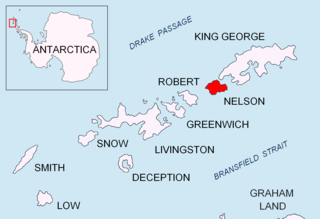
Harmony Point is a point which lies close west of Harmony Cove and forms both the south side of the entrance to Malak Sechko Cove and the western extremity of Guangzhou Peninsula and Nelson Island, in the South Shetland Islands of Antarctica. It was charted in 1935 by Discovery Investigations personnel on the Discovery II, and named from association with Harmony Cove.

Lynch Island is an island lying in the eastern part of Marshall Bay, close off the south coast of Coronation Island in the South Orkney Islands, Antarctica.
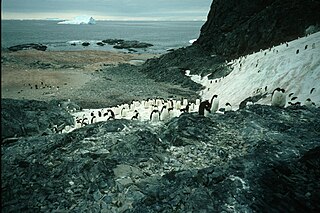
Lagotellerie Island is an island 1.9 kilometres (1 nmi) long, lying 3.7 kilometres (2 nmi) west of Horseshoe Island in Marguerite Bay, off the west coast of Graham Land, Antarctica. It was discovered and named by the French Antarctic Expedition, 1908–10, under Jean-Baptiste Charcot.
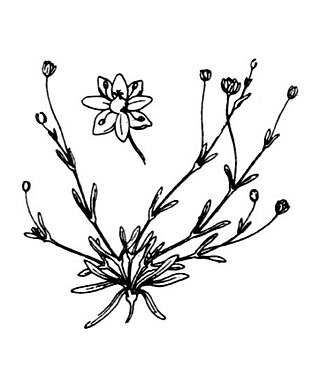
Sagina maritima is a species of flowering plant in the family Caryophyllaceae known by the common name sea pearlwort. It is found throughout Europe, Southwest Asia, North Africa, the Canary Islands and the Azores.
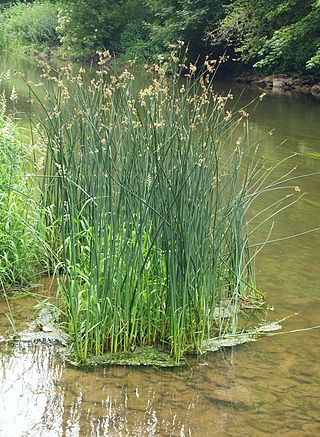
Bulrush is a vernacular name for several large wetland grass-like plants